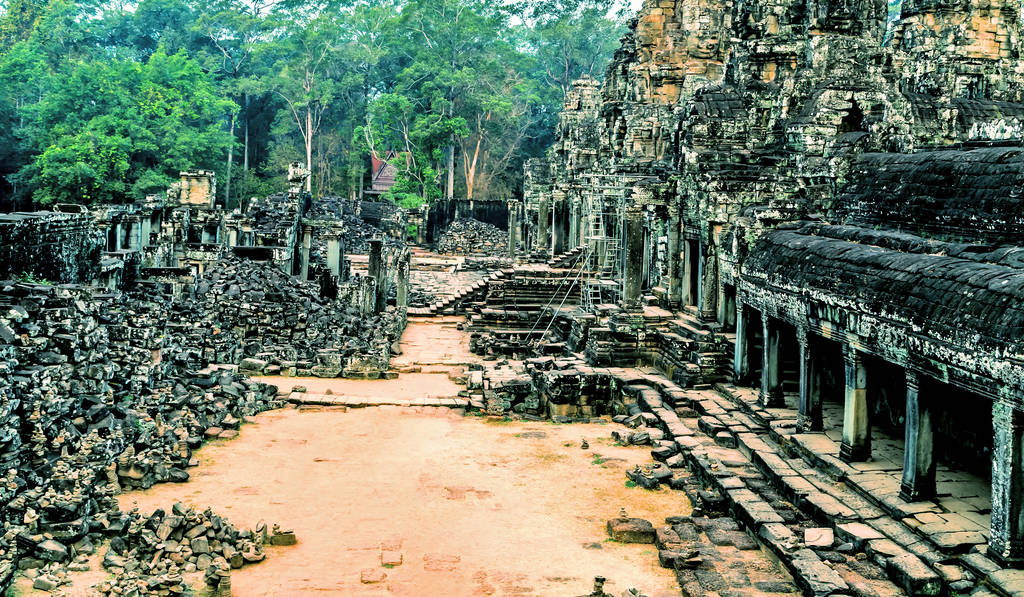As you step through the ancient stone archways of Angkor Wat, it’s as if you’ve slipped through a time portal back to the 12th century.
This architectural marvel isn’t just a relic of the past; it’s a living museum, whispering secrets of the Khmer Empire to those who wander its sacred halls.
You’ll find yourself captivated by the labyrinth of corridors, each turn revealing another masterpiece carved in stone.
Yet, as the sunlight dances through the towering trees, casting shadows that play hide and seek with the gods and demons etched into the walls, you realize you’re only at the threshold.
The true essence of Angkor Wat’s splendor and mystery lies deeper within, beckoning you to explore further and uncover what lies hidden in its heart.
Key Takeaways
- Angkor Wat’s central tower symbolizes Mount Meru, reflecting Hindu cosmology.
- The temple showcases a blend of architectural influences and celestial alignment.
- Intricate bas-reliefs narrate Hindu mythology and historical tales in stone.
- Spiritual rituals and artistry in the outer complex enrich the exploration experience.
Unveiling the History
While exploring the origins of Angkor Wat, it’s crucial to recognize that this architectural wonder, initially known as Yasodharapura, epitomized the zenith of the Khmer Empire’s grandiosity.
Constructed under the reign of Suryavarman II, the meticulous planning and execution of Angkor Wat mirrored the empire’s unparalleled ambition.
The construction, spanning 28 years, wasn’t just an architectural endeavor; it was a spiritual quest. The builders sought to materialize Hindu mythology through stone, with the central tower symbolizing Mount Meru, the home of the gods.
The Khmer architecture, observed in the layout and design of Angkor Wat, showcases a sophisticated understanding of symmetry, cosmology, and religious devotion.
The depiction of Hindu gods etched into the walls narrates tales from an era when religion dominated every aspect of life.
It’s this intricate craftsmanship that caught the eye of explorer Henri Mouhot in 1860, propelling Angkor Wat into the global consciousness.
His descriptions paved the way for Angkor Wat’s recognition as a UNESCO World Heritage site, underscoring its historical and architectural significance.
The ancient temples of Angkor Wat stand today as a testament to the ingenuity and spiritual fervor of the Khmer Empire. Their preservation allows us to delve into a past where architecture was a bridge between the earthly and the divine.
Architectural Marvels Explored
Exploring the origins of Angkor Wat sets the stage for a closer examination of its architectural marvels, where the empire’s profound understanding of celestial bodies and mythology materializes into stone and art.
The central tower, an embodiment of Mount Meru, showcases the Khmer Empire’s architectural prowess.
This symbolic representation isn’t merely artistic but deeply intertwined with the empire’s spiritual vision, illustrating a universe centered around this mythical peak.
The meticulous astronomical alignment of Angkor Wat’s layout underscores the Khmer Empire’s advanced grasp of celestial dynamics.
This alignment isn’t coincidental but a deliberate design choice, reflecting a universe in harmony with the cosmos.
The labor of thousands who carved intricate bas-reliefs into the temple’s walls brought this celestial vision to life, infusing each sculpture with a level of artistic detail that speaks volumes of the empire’s dedication to craftsmanship.
Cultural influences from Indian, Khmer, and Chinese traditions converge in Angkor Wat, creating a unique architectural tapestry.
These influences are evident in the diverse artistic styles present, from the layout to the smallest decorative detail.
The design of Angkor Wat, mirroring the cyclical nature of the universe, adds a profound philosophical layer to its architectural marvels, inviting viewers to ponder the cyclical universe’s deeper meaning.
The Spiritual Significance
Angkor Wat’s spiritual essence, deeply rooted in Hindu cosmology, elevates it from a mere architectural feat to a profound symbol of the universe’s divine order.
At its core, this magnificent temple mirrors the Hindu universe, with the central tower symbolizing Mount Meru, the cosmic axis, around which all celestial bodies revolve.
This alignment isn’t merely structural but embodies astronomical and astrological significance, reflecting the Khmer Empire’s sophisticated understanding of the cosmos.
The temple’s layout, designed with precise astronomical alignment, serves as a terrestrial map of the Hindu cosmic vision.
It’s in these sacred precincts, adorned with intricate carvings and sculptures depicting scenes from Hindu mythology, that you encounter the temple’s spiritual significance.
These images aren’t just art; they’re a manifestation of divine narratives, making Angkor Wat a living tribute to these ancient tales.
Your journey through Angkor Wat allows you to experience the spiritual ambiance firsthand, through its sacred shrines, galleries, and bas-reliefs.
The ongoing rituals and ceremonies performed by local monks within its walls further enhance this spiritual experience, connecting you to a tradition that transcends time.
Here, the spiritual significance of Angkor Wat is palpable, offering a window into a world where architecture and spirituality intertwine to reflect a deeply held belief in the divine order of the universe.
Artistry in Stone
Beyond the spiritual significance of Angkor Wat, the temple’s artistry in stone reveals the Khmer Empire’s unparalleled commitment to craftsmanship and beauty.
The intricate carvings that adorn the temple walls do more than just decorate; they serve as a narrative thread, weaving through Hindu epics like the Ramayana and Mahabharata.
Through these stories carved in stone, you’re offered a glimpse into the empire’s rich cultural beliefs and historical depth.
The stone sculptures stand as testaments to the Khmer Empire’s artistic excellence. Their detailed craftsmanship and precision embody an era where artistry wasn’t just appreciated but revered.
Among these, the bas-reliefs stand out, narrating historical events and religious stories with a level of detail that invites you to lean closer, to study each line and curve.
Artistic motifs are abundant, featuring celestial dancers, gods, demons, and mythical creatures, each contributing to the temple’s architectural beauty.
The stone pillars and lintels, adorned with ornate floral designs and symbolic motifs, showcase the intricate patterns that define Angkor Wat’s elegance.
Through these elements, Angkor Wat’s artistry in stone transcends mere decoration, embodying the empire’s spiritual and cultural ethos.
Exploring the Outer Complex
Stepping into the outer complex of Angkor Wat, you’re immediately drawn into a world where architectural grandeur and intricate bas-reliefs narrate the Khmer Empire’s rich tapestry of history and mythology.
This expanse, a testimony to the artistic and architectural achievements of the Khmer temples, unfolds a panorama of galleries adorned with carvings that breathe life into mythological scenes and celestial beings.
These outer walls serve not just as fortifications but as canvases displaying the prowess and religious fervor of an empire.
The depictions range from gods in battle to serene assemblies of demons and deities, each carving offering a glimpse into the spiritual world that shaped the Khmer psyche.
Amidst this splendor lie the libraries and towers, integral components of the outer complex. The libraries, repositories of knowledge, and the towering structures signify the intellectual and spiritual aspirations of the Khmer Empire.
The courtyards that intersperse these buildings further accentuate the architectural grandeur, providing spaces for contemplation and admiration.
Exploring the outer complex, you’re engaging with the layers of historical and cultural significance embedded within Angkor Wat.
Each element, from the celestial carvings to the towering libraries, contributes to understanding the depth of devotion and artistic sophistication that defined the Khmer Empire.
Conclusion
As you step back from the labyrinthine corridors of Angkor Wat, you’ve traversed a bridge not just of stone, but of time, connecting you to the heart of the Khmer Empire.
The architectural prowess, a symphony in stone, whispers tales of devotion and artistry that echo in the chambers of history.
This journey isn’t merely about witnessing a relic; it’s an exploration of humanity’s enduring spirit to create, worship, and immortalize.
Angkor Wat stands as a testament to the intricate dance between spirituality, art, and architecture, inviting you to look deeper into the past to understand the present.



